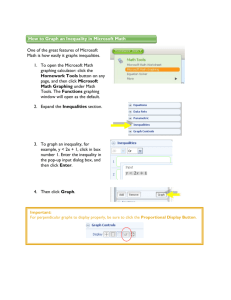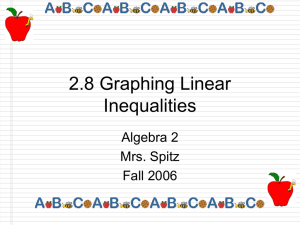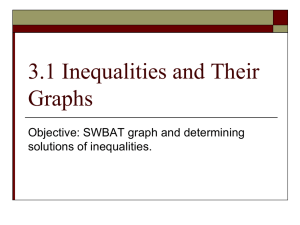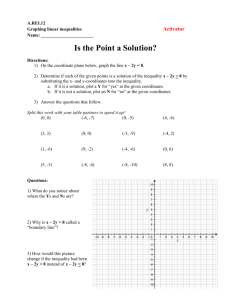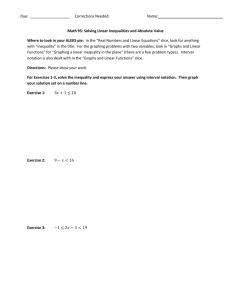Inequalities Lesson Plan
advertisement
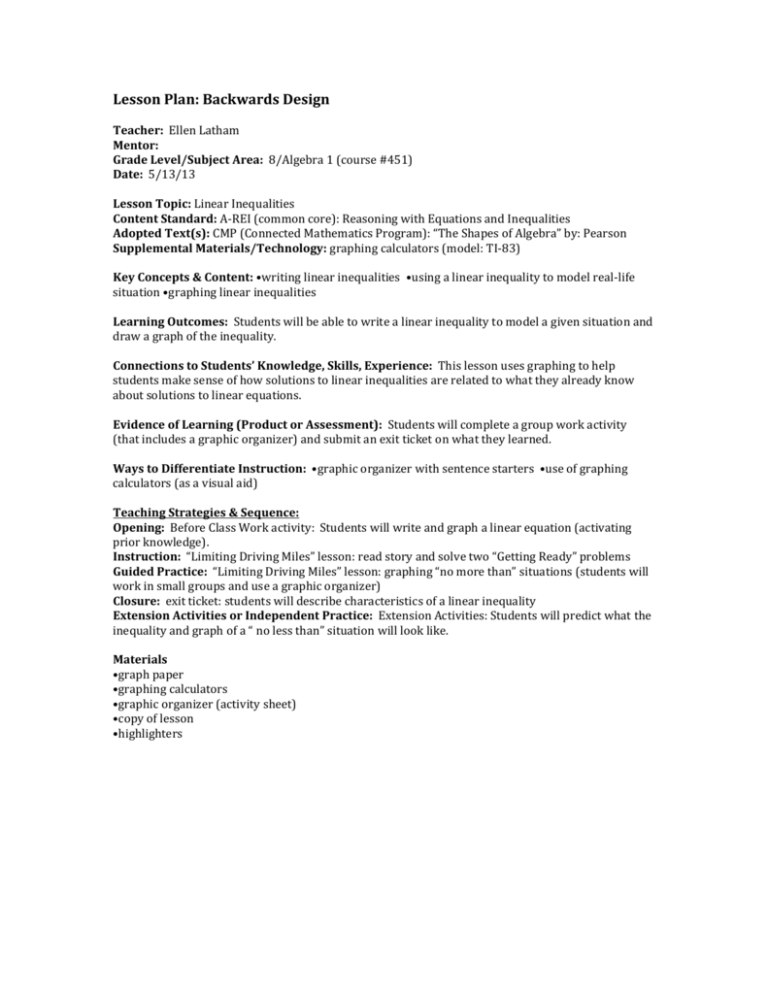
Lesson Plan: Backwards Design Teacher: Ellen Latham Mentor: Grade Level/Subject Area: 8/Algebra 1 (course #451) Date: 5/13/13 Lesson Topic: Linear Inequalities Content Standard: A-REI (common core): Reasoning with Equations and Inequalities Adopted Text(s): CMP (Connected Mathematics Program): “The Shapes of Algebra” by: Pearson Supplemental Materials/Technology: graphing calculators (model: TI-83) Key Concepts & Content: •writing linear inequalities •using a linear inequality to model real-life situation •graphing linear inequalities Learning Outcomes: Students will be able to write a linear inequality to model a given situation and draw a graph of the inequality. Connections to Students’ Knowledge, Skills, Experience: This lesson uses graphing to help students make sense of how solutions to linear inequalities are related to what they already know about solutions to linear equations. Evidence of Learning (Product or Assessment): Students will complete a group work activity (that includes a graphic organizer) and submit an exit ticket on what they learned. Ways to Differentiate Instruction: •graphic organizer with sentence starters •use of graphing calculators (as a visual aid) Teaching Strategies & Sequence: Opening: Before Class Work activity: Students will write and graph a linear equation (activating prior knowledge). Instruction: “Limiting Driving Miles” lesson: read story and solve two “Getting Ready” problems Guided Practice: “Limiting Driving Miles” lesson: graphing “no more than” situations (students will work in small groups and use a graphic organizer) Closure: exit ticket: students will describe characteristics of a linear inequality Extension Activities or Independent Practice: Extension Activities: Students will predict what the inequality and graph of a “ no less than” situation will look like. Materials •graph paper •graphing calculators •graphic organizer (activity sheet) •copy of lesson •highlighters Lesson Planning Guide Teacher: Ellen Latham Mentor: Grade Level/Subject Area: 8/Algebra 1 (course #451) Date: 5/13/13 Learning Objective What is the key standard addressed in this lesson? A-REI (common core): Reasoning with Equations and Inequalities Language Objective What is the language objective? Students will be able to describe characteristics of a linear inequality (in terms of an inequality and graph). Evidence of Learning What data (student work, observations) will you collect to show that students understand the main teaching point? •group work activity sheet: graphic organizer •exit ticket asking students to describe characteristics of a linear inequality Key Concepts and Essential Questions What is the main teaching point? Students will be able to write and graph a linear inequality. What essential question(s) can be asked to demonstrate understanding of key concept(s)? How do you represent a linear inequality on a graph? What symbols are included in a linear inequality and what do they represent? Positive and Productive Environment What routines, procedures and norms need to be in place for students to access the teaching point? Students must be familiar with translating between a graph and its equation (modeled during the before class work exercise). What are step-by-step instructions for each routine or procedure? What do students need to know? Students will be asked to name points on a graph and explain how each point is represented in the equation (before class work) or inequality (lesson). Students will also be asked to explain how the equation (before class work) or inequality (lesson) is represented in its graph. Teaching Sequence: Opening: Students will write and graph a linear equation. What do I expect students to be able to do and say? How will I check for understanding? Students will name points on the line and explain how these points are represented on the equation. Direct Instruction: “Limiting Driving Miles” lesson: read story and solve two “getting ready” problems What do I expect students to be able to do and say? How will I check for understanding? Students will name and share ten points on a coordinate grid that satisfy the given situation. Shared Experience and Guided Practice: “Limiting Driving Miles” lesson: graphing “no more than” situations (activity sheet) What do I expect students to be able to do and say? How will I check for understanding? Students will plot their ten points and describe the region that these points (solutions) lie in. Guided Practice: “Limiting Driving Miles” lesson: “no more than” situations (activity sheet) What do I expect students to be able to do and say? How will I check for understanding? Students will discuss the region where the points do not meet the condition and will offer a possible inequality to represent the graph. Independent Practice: “Limiting Driving Miles” lesson: graphing “no more than” situations (activity sheet) What do I expect students to be able to do and say? How will I check for understanding? Students will construct a graph and write an inequality for a similar problem to the one above. Closure: exit ticket What do I expect students to be able to do and say? How will I check for understanding? Students will describe characteristics of a linear inequality. Adaptations or Accommodations: •graphing calculators: visual aid •group dynamics: carefully selected group composition Materials/Resources: •graph paper •graphing calculators •graphic organizer (activity sheet) •copy of lesson •highlighters
